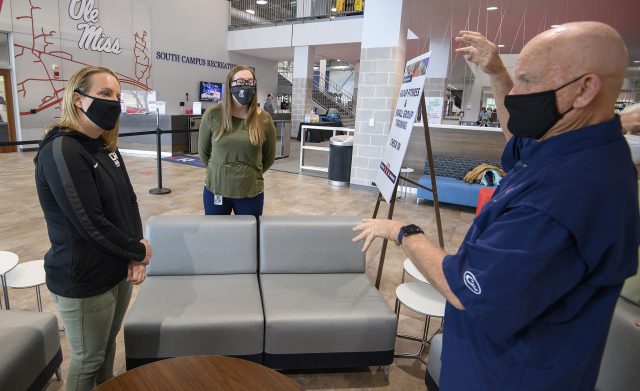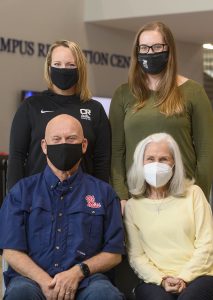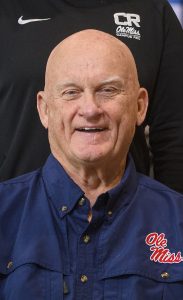
UM staff members Shannon Richardson (left) and Gabby Sokol visit with Rob Barber inside the South Campus Recreation Center. Richardson and Sokol helped save Barber’s life recently after he went into cardiac arrest during a workout. Photo by Thomas Graning/Ole Miss Digital Imaging Services
OXFORD, Miss. – He doesn’t remember it, but Rob Barber’s heart stopped beating for almost a full minute after he collapsed recently while exercising at the University of Mississippi‘s South Campus Recreation Center.
Though the event is for now only a blank spot in his memory, he knows if not for the quick actions of Shannon Richardson, UM assistant director of campus recreation for Ole Miss Outdoors, and Gabby Sokol, assistant director of campus recreation for intramural sports and clubs, and the well-trained staff of SCRC, he wouldn’t have survived.
They rendered CPR, dialed 911 within seconds and were able to use an onsite defibrillator to restore his heartbeat when he collapsed Dec. 2. These actions led to Barber receiving medical attention quickly enough that he was able to walk away without any neurological damage.
He’s recovering after having three stents placed to fix blockages after being rushed by ambulance to Baptist Memorial Hospital-North Mississippi, just down the street. Barber gives Ole Miss credit for saving his life, and says he’s forever thankful.
“I am a testimony to how well run the place is, and how well prepared they are for whatever the situation may be,” Barber said. “I can’t say enough good things about Gabby and Shannon, and the entire staff. They’re so well trained and professional.
“It’s so much more than a gym.”
The SCRC, the university’s 100,000-square-foot hub of holistic wellness and recreation, is the go-to workout spot for Barber and his wife, Janie. The facility, which opened in 2019, has functional training space, an indoor climbing wall, fitness space, three fitness studios, two basketball courts, a multiactivity court, a walking and jogging track, a classroom with a demonstration kitchen and a convenience store.
The facility is used by faculty, staff, students, retirees and community members such as Barber, an active septuagenarian from Oxford, who uses it regularly. He was working out there Dec. 2 when he collapsed on a treadmill.
He was cleared by a doctor to be doing cardio, but something happened that day. His memory of the event starts with him exercising but doesn’t resume until about a week later, when he was recovering from his surgery at the hospital.
“It is a blank to me,” Barber said. “I remember nothing from Dec. 1 until Dec. 8. No memory. I talked to the doctors and the guys from cardiac rehab, and I was functioning, but I don’t remember it at all.”
He’s doing well after surgery and smiles a lot when he talks about those who helped him.
Richardson was working in an office with Sokol when a student worker alerted them to the emergency. They quickly sprang into action.
“It was not a normal work day, that’s for sure,” Richardson said. “His pallor was not good, his breathing was labored and then he lost pulse in the next minute.
“We started CPR and couldn’t feel a pulse, or any breathing. We came back with the automatic defibrillator machine, which reads the heart rhythm and delivers a shock to the patient to return the heart to normal rhythm.”
Once Barber regained a pulse and began to breathe, he was taken to the hospital and further stabilized by the ER team, and then cardiologist Dr. Justin May performed a stenting procedure to fix the blockages.
Dr. Preston Gallaher, assistant medical director for the ER, was on duty that day and agrees with the assessment that Richardson and Sokol saved his life.
“Shannon and her team’s efforts were truly heroic, and without their training and preparation for that moment, Mr. Barber would have had a much different outcome,” Gallaher said. “Fortunately, he had a great outcome – one that defied all the odds of cardiac arrest – thanks to the early, rapid, lifesaving interventions he received at the South Campus Recreation Center.”
The doctor noted how they followed their training, doing CPR, and when it was unsuccessful, using the automatic defibrillator, which determined that Barber’s heart needed to be shocked back into rhythm. The key was to rely on training and to act quickly.

Rob Barber (front, left) suffered a cardiac arrest while working out with his wife, Janie Barber (right), at the university’s South Campus Recreation Center. UM staff members Shannon Richardson (back, left) and Gabby Sokol used CPR and their training to help save his life. Photo by Thomas Graning/Ole Miss Digital Imaging Services
Barber said he was impressed with their efforts, after having the story recounted to him in a recent meeting with the SCRC staff.
“Gabby told me she was determined she was going to make sure my blood was flowing and that I was breathing again,” Barber said with a grin. “I am still a little sore where she was doing the chest compressions, but I’m very thankful she was so well trained. It’s amazing.
“She did it exactly right without ever having had to do that before.”
Richardson and Sokol were able to quickly get to him with the AED machine, which automatically checks for an arrhythmia and delivers a shock if one is found. Such equipment is critical for saving lives in those situations, Gallaher said.
“They did everything flawlessly at the scene,” Gallaher said. “Truly, his life was saved way before that with the hours of training and preparation over the years by Shannon and her team. They were prepared and knew what to do and acted quickly.”
But more than that, the fact that his pulse was restored quickly allowed him a chance to make a full recovery and avoid the neurological damage many suffer in similar situations.
“Very few people survive out-of-hospital cardiac arrest,” Gallaher said. “Current statistics are approximately only 10% of people survive. Even within that number, many who survive do so with a significant long-term neurologic impairment or chronic disability.
“What I mean by that is: when you ‘survive’ to go home from the hospital, are you going home to play with your grandkids and do your taxes, or are you being discharged to a nursing home? That’s a big difference. In that sense, ‘time is brain’ when it comes to a cardiac arrest, and every minute is critical.”
Barber, who was recuperating at home recently and in good spirits, said he doesn’t really want to remember his near-death experience anytime soon.
“I chose not to view the security film they had of me when I collapsed,” he said.
When Barber went into cardiac distress, his wife was downstairs, having already finished her workout. A student worker saw Barber fall and quickly propped him into the “recovery” position so that if he were to vomit, he wouldn’t choke.
As he was doing that, Richardson and Sokol, who were working in an office nearby, sprang into action as the highest-trained in medical emergencies.
Sokol said she really didn’t have time to think. She relied on her training, and the protocols in place to deal with a medical emergency. The machine really worked, she said.
“Within a minute of Mr. Barber losing his pulse, we were able to start his heart beating again, ” Sokol said. “I was nervous, but I absolutely knew what to do.”
Helping someone’s heart begin to beat again isn’t something she hopes to go through again, Sokol said. She can only imagine what the experience was like for Barber.
“It was truly a team effort,” she said. “From someone who played sports, there has never been a more important team effort in my life.
“I look back and I am grateful for all the time I put into my training, and also all the time I took it seriously. I couldn’t be more thankful for the outcome for Mr. Barber.”
University Police Department and the campus recreation staff kept Barber in good shape until EMTs arrived and also assisted Barber’s wife, Janie.
“A UPD officer (Chris Kinsey) took me to the hospital and even called later to check on Rob,” she said. “I got a call from (campus recreation Director Peter Tulchinsky) and I got an email from him asking if I could send them an update on Rob.
“They were all very kind to me when I was still very shaky. I was really thankful for their care and concern.”
Richardson said she was also incredibly impressed with the poise and the level of care her student workers responded with when called.
“We were able to get Mr. Barber out of there as quickly as possible,” Richardson said. “Everybody just came together. We have the training and put it into the action.
“During the emergency, I prayed for Mr. Barber and I thank the Lord that it was a positive outcome.”
Barber is continuing his recovery with plans to return to the recreation center to work out again in the near future. Whatever happens, though, he says he’ll never forget the chance to keep living that he has been given.
“Needless to say, Shannon and Gabby are now on the top of my Christmas list every year,” he said.
